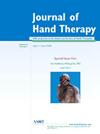Patient-centered care in the conservative management of an unstable proximal phalanx fracture: A case report
IF 1.8
4区 医学
Q2 ORTHOPEDICS
引用次数: 0
Abstract
Background
Proximal phalangeal fractures are common yet challenging due to their inherent instability.
Purpose
This study presents a case for patient-centered care and a nonsurgical management pathway.
Study Design
Case report.
Methods
M, a 56-year-old male, sustained a comminuted oblique proximal phalanx fracture to his left nondominant small finger while playing football. Five days post injury, the fracture was reduced with local anesthetic and manipulation (LAMP). The injury was managed conservatively with a full-time hand-based orthosis with metacarpophalangeal joint flexion, and buddy taping. One week later, the fracture had lost reduction and significantly displaced. Instead of converting to surgery, a further LAMP (LAMP2) was performed, and conservative management continued. Outcomes were collected at baseline, 6, 12, and 15 weeks, and 10 months following LAMP2.
Results
By 12 weeks, M had a full range of motion, minimal pain, no difficulty with personal daily activities, and resumed full manual labor work duties and gym workouts. Quality of life was reported as high from 6 weeks. M was extremely satisfied.
Conclusions
Conservative management of an initially unstable proximal phalanx reduced by LAMP, with a second LAMP one week later, demonstrated excellent outcomes and could be a possible management pathway for similar patients.
以患者为中心的保守治疗不稳定近端指骨骨折1例报告。
背景:近端指骨骨折是常见的,但由于其固有的不稳定性具有挑战性。目的:本研究提出了一个以患者为中心的护理和非手术治疗途径的案例。研究设计:病例报告。方法:M, 56岁男性,在踢足球时左非优势小指发生粉碎性斜近端指骨骨折。伤后5天,采用局麻手法(LAMP)复位骨折。该损伤采用全手矫形器保守治疗,伴掌指关节屈曲,伴伴胶布。一周后,骨折失去复位并明显移位。患者没有进行手术治疗,而是进行了进一步的LAMP (LAMP2)治疗,并继续进行保守治疗。在LAMP2治疗后的基线、6周、12周、15周和10个月收集结果。结果:到12周时,M活动范围全,疼痛最小,个人日常活动没有困难,并恢复了完全的体力劳动工作职责和健身房锻炼。据报道,从6周开始,生活质量就很高。M非常满意。结论:保守治疗经LAMP复位的最初不稳定的近端指骨,一周后进行第二次LAMP治疗,显示出良好的效果,可能是类似患者的治疗途径。
本文章由计算机程序翻译,如有差异,请以英文原文为准。
求助全文
约1分钟内获得全文
求助全文
来源期刊

Journal of Hand Therapy
医学-外科
CiteScore
3.50
自引率
10.00%
发文量
65
审稿时长
19.2 weeks
期刊介绍:
The Journal of Hand Therapy is designed for hand therapists, occupational and physical therapists, and other hand specialists involved in the rehabilitation of disabling hand problems. The Journal functions as a source of education and information by publishing scientific and clinical articles. Regular features include original reports, clinical reviews, case studies, editorials, and book reviews.
 求助内容:
求助内容: 应助结果提醒方式:
应助结果提醒方式:


